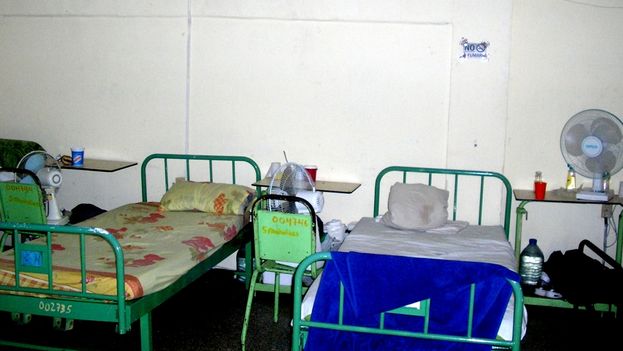
![]() 14ymedio, Hector Reyes, Santa Clara, 13 June 2015 — His story starts with a bottle and ends in a psychiatric ward. More precisely, it ends in the rehab ward of Santa Clara Psychiatric Hospital. With the help of pills and shots, Néstor will try staying for 21 days in order to escape alcoholism’s downward spiral.
14ymedio, Hector Reyes, Santa Clara, 13 June 2015 — His story starts with a bottle and ends in a psychiatric ward. More precisely, it ends in the rehab ward of Santa Clara Psychiatric Hospital. With the help of pills and shots, Néstor will try staying for 21 days in order to escape alcoholism’s downward spiral.
The room where the young man is hospitalized does not have a refrigerator, or a television, or lockers to store his belongings. It has only one bathroom without water. Once in a while, one of the six men confined in that small space with only a one working fan, asks out loud “Why?” but nobody in that “cage” answers him. continue reading
Routine is part of the treatment. Wake up, take medications, doze off until breakfast, wait for the meeting with the therapist, snack time, lunch, and more medications. Everyday is the same for three weeks in order to prevent any attempt to fill in the hours with rum and hard liquor. The drugs used to combat addiction range from Carbamazepine to one dose of dextrose per day.
Treatment also requires isolation. Psychiatric patients have the right to freely visit their homes, but alcoholics can only leave the premises if accompanied by a medical staff member. Roque Tejera, another patient hospitalized in that same room believes that being locked up and medicated seems to help. Meanwhile, from a bed at the far side of the room, Lian Morales says that psychotherapy is what gives him the most strength not to relapse.
“I’ve been here six months, and every time I get out, I go back to getting drunk,” explained Orly Ferrer, as he shooed away the flies buzzing all over the room. His story is corroborated by the testimony of doctors and nurses who have seen many patients promise not to drink anymore, and then end up hitting the bars.
Alcoholism ranks among the ten top causes of death in Cuba, and according to official statistics, 45.2% of the population above fifteen years of age consumes alcohol, especially those between 25 and 42.
Alcoholism ranks among the ten top causes of death in Cuba, and according to official statistics, 45.2% of the population above fifteen years of age consumes alcohol
A few months ago, psychiatric expert Dr. Carmen Beatriz Borrego Calzadilla told the official press that the consumption of alcohol is most prevalent among the youth. The health professional stated: “Among adolescents, the consumption of alcohol is often associated with self-determination, fun, entertainment, and modernity.”
Some enter rehab because of family pressure, from families undone by the ravages of alcohol and violence. Others, such as Néstor, sought medical advice in order to be admitted to rehab after a disastrous drunken spree. The Psychiatric Hospital’s emergency room policy states that if a patient arrives on his own will, he will be admitted, if there is a bed available.
They come because they have consumed everything, from rum bought with convertible pesos to homemade concoctions. Noel Ponce, another alcoholic in rehab, says that one of his methods consists of pouring concentrated honey in a sealed tank with a valve. He explained: “You attach a coil to it and heat it up until it bubbles and secretes alcohol.”
Alcoholics from the lowest economic strata, such as retirees and the unemployed, rely on all types of moonshine to quench their daily thirst for alcohol. For many, even the mouthwash available at pharmacies ends up being a way of getting plastered.
Alcoholism is rarely discussed in Cuba, and when the domestic media does focus on it, it almost always does so superficially. The majority of television spots on this issue emphasize its connection to traffic accidents. Programs with a more psychological bent, such as Vale la pena (It’s worth it), attack consumption without mentioning the reasons behind it.
Alcoholism is rarely discussed in Cuba, and when the domestic media does focus on it, it almost always does so superficially
In many Cuban television series and movies there is often an alcoholic, a funny character zigzagging as he urinates from one lamppost to the other. Conversely, the documentary Havana Glue tackles the situation in all its extent and gravity. This movie, directed by the young filmmaker Lupe Alfonso, takes in the opinions of artists, intellectuals, and the average citizen about the consumption of alcohol in Cuban society. It has yet to be broadcast on national television.
In order to help the patients out of the situation they find themselves in when they enter the rehab ward, doctors also recommend physical exercise. Santa Clara Psychiatric Hospital has a room fitted with exercise machines that improve physical and mental health, apart from keeping the patients busy. One of the room’s attendants said: “This space is too small. They should give us the space used for the emergency room.” Due to lack of space, they cannot use the treadmill or the rowing machine.
The other part is made up of psychotherapy, based on the approach of Alcoholics Anonymous, a program that began in 1935 with a New York businessman who began talking to other drinkers about his struggle with sobriety. Today there are more than 100,000 AA groups in about 150 countries.
“Personally, psychotherapy overwhelms me, it depresses me,” commented one of the patients who shares the room with Néstor. Some of the stories shared during sessions raise important issues, while others are heartbreaking or hilarious. The volume increases as the minutes go by and the patients vent.
Since the medical authorities refuse to release statistics, the weight of the problem in rural areas cannot be measured. Six young rural men have just ended up in this small, hot ward of Santa Clara Psychiatric Hospital. When they get out of here, they will return to their small towns, where due to a lack of recreational options, the bottle has become an inseparable companion of social interactions.
Translated by José Badué

